Technology Glossary
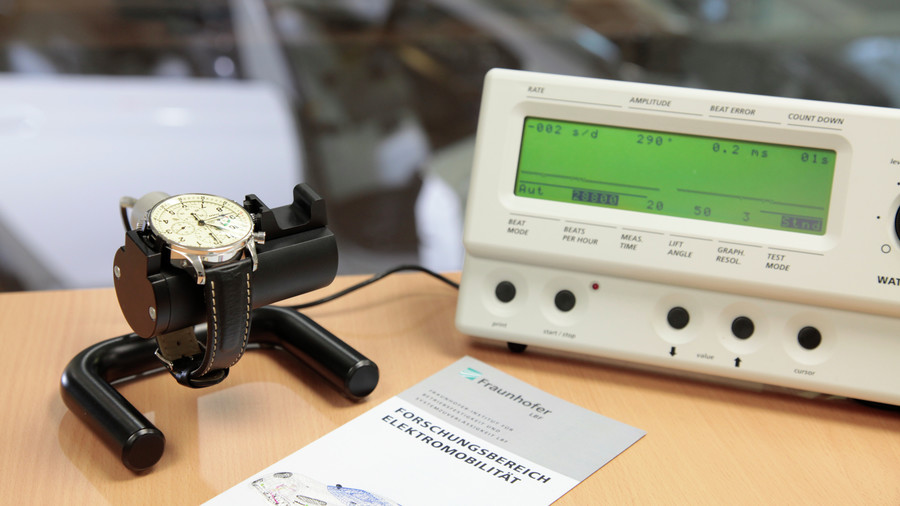
acrylic glass
Glass-like product made from polyacrylic esters.
It is highly break resistance and is resistant to weather and corrosion. Small scratches can easily be polished out.
amplitude
Distance of oscillation (swing or beat).
The amplitude is the maximum angle of rotation of the balance between the point of equilibrium and one of the reversal points of the oscillation. The average amplitude values of most watch movements made today are between 250° and 300°. As the lubricant ages, this value gradually falls.
DIAPAL Technology deals with this problem at the root, by dispensing with the need for oil altogether.
angling
Decorative processing of edge contours, particularly on the bridges and cocks of a high quality movement.
During angling, a decorative bevelled edge is created (the edge is ‘angled’). Angling is a highly skilled finishing technique used instead of the conventional deburring/rounding of edge contours.
anti-magnetic
Sensitive to magnetic field interference up to a certain level.
Devices or equipment, the functions of which are protected from magnetic interference by the use of suitable materials and/or screening up to a specified level, are antimagnetic.
anti-reflection
When light hits a glass surface it splits in two: one part of the light is bounced back as a reflection, the other goes into the glass. Reflections severely impair the readability of a watch; they reduce both the light permeability of the crystal and also the clarity of the image. Diffuse points of light and reflected images in non-antireflective glass can in some cases be more dominant than the dial itself.
A very thin coating of a suitable translucent material is used to make glass anti-reflective. This coating is generally vapor deposited onto the glass in a vacuum. The splitting of the light mentioned above then takes place both on the surface of the glass and also on the surface of the thin anti-reflective layer. The light reflected from this layer overlaps with that from the glass itself. The layer needs to be thick enough for the light reflected from the different surfaces to cancel each other out through destructive interference. Destructive interference, in simple terms, is when two opposing waves are offset so that the peak of one wave always coincides with a trough of the other, thereby canceling each other out. Such a displacement occurs because the light reflected from the surface of the glass has to travel slightly further than that from the surface of the coating to ensure overlapping. A further precondition for mutual cancellation is that both waves must have the same amplitude. Multiple layers with different types of coating and thicknesses are required to create an anti-reflective effect at different wavelengths (colours) of visible light.
Sinn's sapphire crystals are always coated on both sides to ensure optimum readability. Colorless anti-reflective coatings are used, created using a precision-controlled coating technique, to ensure that the dials show their true color.
antimagnetic watches
According to DIN, watches which do not stop when exposed to a magnetic field (see magnetism) and the accuracy of which does not exceed specified limits when exposed to a magnetic field may be described as antimagnetic.
DIN guideline 8309 stipulates that mechanical watches are antimagnetic if their rate change does not exceed +/- 30 seconds per day after exposure to a magnetic field of 6 mT (corresponds to 4800 A/M) (movement diameter larger than 20 mm). The watch should also not stop when exposed to a magnetic field of this strength.
Mechanical watches react to magnetic fields primarily due to the fact that they contain temperature-compensating hairsprings (see Nivarox).
At Sinn, we offer additional magnetic field protection in some watches.
Ar-Dehumidifying Technology
Sinn technology to reduce ageing processes inside the watch. The Ar-Dehumidifying Technology is based on three technical elements: a drying capsule, EDR seals (Extreme Diffusion-Reducing) and a protective gas filling.
See Sinn Technology Ar-Dehumidifying Technology.
Argentium®
Designation for a silver alloy that is alloyed with the element germanium to form a tarnish protection.
Silver in its pure form or in the common 925 sterling alloy is known to show tarnishing behaviour, which is noticeable by a superficial black discolouration. Therefore, silver items such as cutlery or jewellery, if they are really free of electroplated coatings with rhodium, must be cleaned regularly. This tarnishing is not a sign of corrosion. Silver is a precious metal that is immune to corrosive material transformation processes, which are called ‘rusting’ in steel alloys. However, silver reacts on its surface with sulphur, which is supplied by skin contact or from the atmosphere.
This leads to the visible darkening, which can be reversed chemically with silver polishing cloths or suitable household remedies, such as contacted aluminium foil and salt water. A similar surface reaction can be caused by contact with some disinfectants – for example, in swimming pools – or direct contact with some cleaning agents. Argentium® silver now forms a protective film of germanium oxide on its surface. This layer considerably slows down the aforementioned tarnishing process. In addition, a golden hue develops rather than turning black. This can be removed with an Argentium® care cloth. The principle of the surface oxide layer is reminiscent of the formation of a passive layer of chromium oxide, on which the corrosion protection of common stainless steels is based.
In our model 1739 Ag B, we use a 935 Argentium® alloy.
balance
The balance, in combination with the hairspring, constitutes the oscillation system of a mechanical watch.
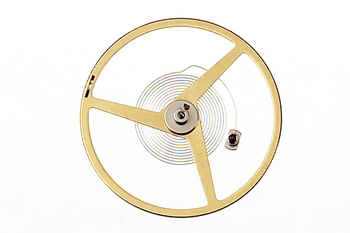
Balances nowadays are nearly always closed metallic wheels with two or three spokes. The balance spring is firmly fastened to the balance shaft. This allows the balance to execute a rotary oscillation which is ultimately responsible for the even running of the watch.
The to-and-fro motion of the balance is translated by means of a small ruby pin (ellipse) into to-and-fro rocking of the anchor. Within this rhythm the anchor, in turn, inhibits the anchor wheel and therefore the entire gear train of the watch (escapement).
The balance is normally made from an alloy called "glucydur". This is a type of beryllium bronze. This material considerably reduces the influence of temperature. The residual temperature error is compensated by the Nivarox spring.
An older, historical type of balance is the screw balance. This was first used in the form of the compensating balance which is split at two points to compensate the temperature error; it has a bi-metal construction. The split balance wheel creates the two balance "wings". The adjustment screws inserted on the sides were used to individually compensate the large temperature error of earlier steel balance springs and to carry out the basic adjustment of the movement. To compensate for the softening and lengthening of the balance spring as the temperature rose, the inertia of the balance was made obversely dependent upon the temperature. The bi-metallic effect caused the two balance wings to bend inwards when the temperature increased. This reduced their inertia, mirroring the principle behind a figure skater lowering his arms while pirouetting to increase his speed of rotation.
Monometallic balances fitted with side adjustment screws for the basic regulation of the oscillation duration are still valued today as means of upholding this watchmaking tradition. In homage to this tradition, balances in pocket watch calibres are fitted with side screws to give them a high moment of inertia and to create the characteristic 18,000 vibrations per hour found in many pocket watches.
bar
Physical unit of pressure, i.e. force per surface area.
1 bar = 100 kPa = 0,1 MPa
One bar corresponds roughly to the average atmospheric air pressure at sea level. Water (hydrostatic) pressure increases by approx. one bar for every 10 m of water depth. A watch is therefore subjected to one additional bar for every 10 m of diving depth (quod vide pressure resistance and water-resistance).
1 bar corresponds roughly to the weight of 1 kg per cm² (1 bar = 10 N/cm²). The precise value depends on the location on Earth. The gravitational acceleration varies between 9.78 and 9.83 m/s² Taking the mean value (9.81) as the basis, 1 bar corresponds to a weight of 1019.4 g per cm² .
Black Hard Coating
A hard TiAlCN (titanium-aluminium-carbonitrite) coating, applied using a so-called PVD process. This layer has a surface hardness of more than 2000 HV.
See Sinn Technology Black Hard Coating.
Bullhead
A watch where the control elements are at the top of the case.
The term ‘bullhead’ refers to the position of the crown and push-piece at the top of the case. This arrangement means that the watch resembles a bull’s head. It also represents an analogy to the classic stopwatch shape and motor sport. The first bullhead watches came onto the market at the end of the 1960s. The positioning of the control elements on the top of the case requires an extremely sophisticated case construction. In order to be able to operate the crown and the push-piece comfortably on the wrist, Sinn Spezialuhren model R500 has a dial that slopes downwards from top to bottom, angling the watch towards the wearer.
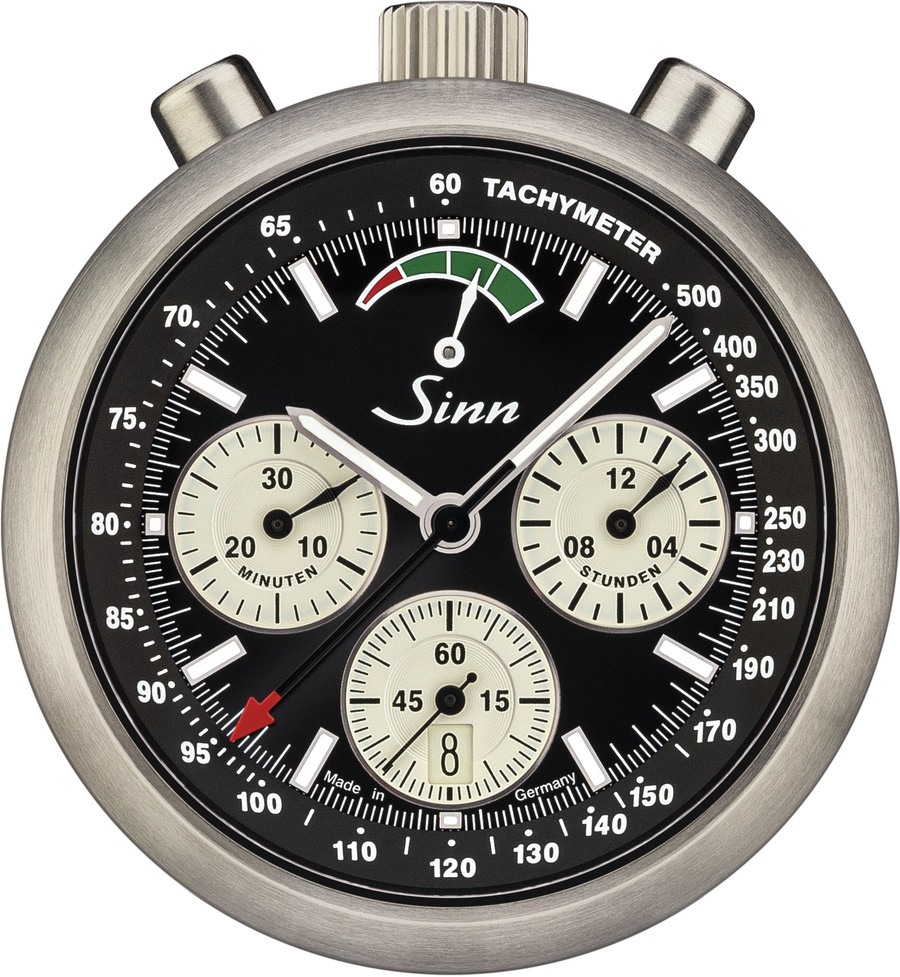
calibre
Another word for a movement.
The term is usually used in connection with a numerical movement name such as ‘Calibre ETA 7750’, for example. Unlike calibre information in weapons technology, in watchmaking the term ‘calibre’ has nothing to do with the size of the movement.
captive bezel
Outer bezel with a special design to prevent it from being lost.
Bezels are conventionally attached to the body of the case using a snap-in mechanism. If knocked, the ring can, in the worst case, become detached and the set time lost. Many our watches are therefore fitted with a safety system which overcomes this design weakness.
captive safety bezel
The captive safety bezel in the U1000 diver's chronograph also includes a further safety feature besides its captive design: rotation protection. See Sinn Technology: Captive Safety Bezel.
chronograph
A chronograph is a timepiece with a stop mechanism which can be used to time the length of a particular procedure.
chronometer quality
Conditions which movements must meet to fulfill the chronometer standard.
Watches or movements with particularly accurate running, confirmed by an official certificate, are designated chronometers. Chronometer movements have to be given a serial number to ensure that the certificate and the movement can be uniquely matched. Chronometer tests are currently carried out and documented almost exclusively by the C.O.S.C. (Contrôle Officiel Suisse des Chronomètres, an independent public-service organization in Switzerland). Just recently, however, the Landesamt für Meß- und Eichwesen Thüringen (Thuringian State Office for Measurement and Calibration) in Glashütte has started offering chronometer tests as the accreditation office of the German Calibration Service in Germany.
The chronometer quality of a mechanical watch movement is determined in part by the special workmanship of certain movement components, partly by precise regulation of the watch. We only use the highest quality products provided by Swiss movement manufacturers in Sinn watches. Basically all these movements can be regulated as chronometers. If desired, our watches can be given a fine-adjustment, i.e. they are of chronometer quality, but are supplied without a certificate.
The specifications of a mechanical chronometer movement include a number of rate accuracy aspects: e.g. the effect of position on the rate, the stability of the rate in each individual position and the temperature dependency of the rate. There is an international standard (ISO 3159) for mechanical movements which correspond to national standard systems (DIN 8319, part 1 and NIHS 95-11).
Because the accuracy of a mechanical watch generally depends on its spatial orientation in the Earth's field of gravity, five test positions for observing the escapement are distinguished (e.g. "dial top", "dial bottom" etc.). The mean of the accuracy values measured in the five test positions should remain within a range of -4 to +6 seconds per day (24 hours) at room temperature (23ºC).
This standard, by itself, is not particularly exacting and would probably be fulfilled by any modern mass-production caliber. However, a chronometer movement must also achieve this mean value with no appreciable accuracy differences between the individual positions. The largest accuracy difference between an upright and horizontal position (more precisely: between "crown left" and "dial top") should be no more than -6 to +8 seconds per day. For the remaining positions: each individual position value should not differ from the average of all five positions by more than 10 seconds per day.
Further demands are placed on the stability of the accuracy in each individual test position. The watch should not deviate by more than 5 seconds per day in any given position (at a constant temperature of 23°C). The mean of the deviations observed in the individual test positions should also be no greater than 2 seconds per day.
Critical demands are also placed on the temperature dependency of the watch’s accuracy. The watch’s accuracy is tested within a temperature range of 8°C to 38°C. The deviation per degree Celsius and day should not exceed +/- 0.6 seconds. Finally there is a test to ensure that the watch regains its accuracy at 23°C, after the temperature change. In a given test position, the accuracy may not differ from the mean accuracy in this position measured before the temperature change by more than +/- 5 seconds per day.
In chronograph movements, the accuracy difference is checked with the stop function turned on and off.
All accuracy measurements are carried out without the use of an electronic timing machine, i.e. the time is read off directly after 24 hours as measured on a test dial. The entire chronometer test takes a total of 15 days.
Up to now there has been no international standard (ISO) for quartz chronometers. In the meantime, the technical possibilities of series production have overtaken the requirements of the Swiss and German standard systems (see e.g. DIN standard 8319, part 2, from 1978). In 2001 the Swiss testing organization C.O.S.C. therefore formulated new criteria for its own testing practice. This placed more stringent requirements on quartz chronometer movements. The test criteria are designed so that quartz movements without special temperature compensation cannot pass the test.
At SINN, we use thermo-compensated ETA movements with a quartz frequency of just over 32 kHz in our UX and 434 models. Although quartz movements with an even higher running accuracy are technically possible in the form of mega-Hertz oscillators, they were only produced temporarily and in small quantities due to their high power consumption and high manufacturing costs.
Due to their temperature compensation, the ETA quartz movements we use are around twenty times more accurate than a conventional quartz movement regulated to room temperature and are currently the most accurate autonomous wristwatch movements.
Column wheel chronograph
A chronograph in which the start, stop and reset functions are controlled by a column wheel.
A column wheel, also called a ratchet wheel, is a pivoting sawtoothed gear wheel to which several columns are attached at right angles. It is made as a single piece, polished and hardened. According to the positioning of the column wheel, holes open up for the levers of the chronograph mechanism which can resolve a previously existing blockage, or the lever touches a column and is lifted up due to its slanted side surfaces. The positioning of the column wheel is altered via the aforementioned sawtoothing at the base of the column wheel.
A coulmn wheel chronograph is much more challenging to produce in terms of manufacturing processes than the usual shifting link. These chronographs are therefore much rarer.
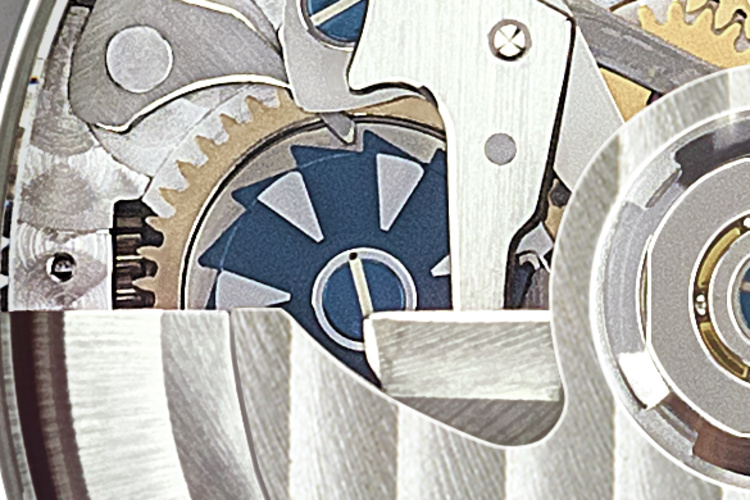
D3-System
In our D3-System watches, the push-piece pins and crown shafts are mounted directly in a fine-finished case aperture, creating a perfect seal to the case.
In conventional designs, the push-piece pin and crown shaft are mounted in the case hole inside a tube insert. The required tube seal not only represents an additional potential source of gas diffusion (see Ar-Dehumidifying Technology), but careless handling can also lead to loss of water resistance with this design. This is because the push-piece pin and the crown shaft can bend in the tube if exposed to lateral knocks, permitting moisture to penetrate. This is a risk which also exists in screwable crowns and push-pieces when they are unscrewed to make an adjustment.
The D3-System permits the crown and push-piece to be integrated in the case, providing reliable protection from lateral knocks and the penetration of dust or moisture.
Damascus steel
A composite material made of two different types of steel. The special characteristic of this material is brought out by surface etching, which reveals an organic pattern of light and dark stripes.
The etching patterns that are characteristic of Damascus steel highlight the stratified composition of the material, which is made up of at least two different types of steel. The separate layers of steel are forge-welded together to form a permanent bond. In the traditional process of manufacturing knives and swords, hard/brittle and softer/elastic types of steel were alternated to combine the respective benefits of resistance to breakage and edge retention. Nowadays, Damascus steel is primarily manufactured for its decorative charm and in appreciation of the forgery craftsmanship.
After a work piece has been welded, forged and hardened, the final step is surface etching to reveal the typical Damascus pattern. This is achieved in an acid bath, where the two types of steel demonstrate varying degrees of corrosion. The strata between the more resistant steel layers wear more quickly so that they become rough and take on a darker grey tone. This gives rise to the typical Damascus texture, which most resembles a wood grain, but can also take the form of more unusual patterns (when the material is twisted during forging, for example).
We decided to use a combination of stainless steels to produce the case material of our 1800 S DAMASZENER, with corrosion resistance almost as high as the other steels we use for our cases. To finish, the work pieces undergo our tried-and-tested TEGIMENT process. In this regard, the stainless steel composite resembles traditional (non-stainless, martensitic) Damascus steels, which are hardened using a heat treatment.
Another point to note is that the dial on our 1800 S DAMASZENER is not designed as a separate component, as is customary; instead, the dial and central part of the case are milled from a complete steel block. This means that the Damascus pattern on the dial continues across the entire case, creating an organic whole.
Deck watches
The deck watch – a portable watch with readability and precision tailored to navigational purposes.
The history of ‘B-Uhren’, or deck watches, began when they were first used as timekeeping equipment on ships.
Once it was possible to make watches that could provide sufficient accuracy at sea, the navigational determination of the longitude was based on the difference between the true local time astronomically determined on the ship and the time ‘taken along on the voyage’ from a harbour (this equated to the time at the harbour’s known longitude). The difference was determined by synchronising a marine chronometer permanently installed on the ship with the harbour time. Smaller, portable precision watches were therefore required for two reasons. Firstly, the precise harbour time had to be ‘transported’ from the nearest observatory to the marine chronometer. Secondly, to conduct astronomical observations at sea, the time on the marine chronometer had to be frequently compared with the time astronomically determined on deck. These tasks were performed by deck watches, which combined a high level of precision with clear readability and, above all, easy portability. The classic deck watch was similar in format to a pocket watch, but slightly larger. At sea, the deck watch would be set to the true local time once or twice a day by observing the sun or other celestial bodies, and the difference between this time and the time on the marine chronometer would then be used to calculate the longitude currently reached.
In the 20th century, a large number of deck watches were made for the military sector. In 1940, the Deutsche Wehrwirtschaftsamt (German Office of Military Economics) forced several well-known manufacturers to produce navigation wristwatches which had to fulfil special requirements established by the Reichsluftfahrtministerium (German Ministry of Aviation). Because the specifications included a narrowly defined model (the company name was not even allowed to feature on the dial), a standardised design emerged during this period. To this day, pilot and deck watches are still based on this historical standard design.
The watches had a standard diameter of 55 mm. From 1941 onwards, there was a prescribed dial pattern with a minute scale from 5 to 55 and an inner circle with an hour scale from 1 to 12. Instead of the ‘60 minute’ marker, this dial features an eye-catching triangle to make the watch’s orientation clear and ensure that it can be quickly and reliably read.
DIAPAL
We select special pairs of materials that work together without lubrication (!) and without causing friction, ensuring long-term accuracy of the movement and particularly of the Swiss anchor escapement.
Sinn trademark: Used for watches featuring DIAPAL Technology.
DIN 8330
At the suggestion and with the help of Sinn Spezialuhren, TESTAF was used shortly after its completion by the German Institute for Standardisation to develop a new standard for pilot watches DIN 8330 "Timekeeping Technology - Pilot watches" for the first time.
Please refer to:DIN_8330_pilot_watches.
Diver's bezel
Generally a rotating bezel that locks by the minute and can only be rotated on one side to prevent unintentional adjustment.
According to DIN 8306 and ISO 6425, a minute graduation must be provided on a diver's rotating bezel in addition to a main marking (e.g. luminous triangle). In addition, the 5-minute division must stand out clearly from the rest of the minute scale.
diver’s bezel
A minute-clicking bezel which can only be rotated on one side to prevent accidental adjustment. It should also be possible to set a diver’s bezel when wearing gloves. Besides the main marking (e.g. luminous triangle) there may also be a minutes scale running clockwise.
diving equipment standard
Diving equipment, such as diving cylinders and breathing apparatus approved in accordance with European norms EN 250:2000 or EN14143:2003, is subjected to various tests to ensure that it functions correctly at low temperatures and in high humidity.
In 2006 we commissioned Germanische Lloyd Hamburg to adapt these standards to wristwatches. Our diving watches were then for the first time formally accepted as integral pieces of diving equipment and tested as such.
The tests are repeated at regular intervals and the results documented as a means of ensuring consistently high quality.
diving watch
Watches specially built for diving which, in compliance with DIN, have to fulfill a range of requirements in addition to being water- and pressure-resistant.
Our diving watches meet the safety requirements and pass the tests stipulated in DIN 8306. This contains the following test criteria:
– Readability
– Accuracy
– Antimagnetism
– Shock-resistance
– Fastening elements
– Air tight under high pressure
– Saltwater resistance
– Scale setting ring or diver’s bezel
– Functional reliability of control features
– Functional reliability of diving watch under high water pressure
– Resilience to temperature stress
– Perfect functioning of crowns, push-pieces and similar control features
– Watertight under high water pressure
Because our diving watches are specially designed for professional diving, we voluntarily have them examined and certified by Germanischer Lloyd in Hamburg (now DNV GL) based on European diving equipment standards.
DNV Certifies Diving Watches
DNV provides technical testing and certification as well as software and independent advisory services to the energy, oil and gas, and maritime industries. See Tests and Certifications: DNV certifies Sinn Diving Watches
EDR seals
Name of sealing materials which have much greater diffusion-inhibiting properties than the conventional case sealing material (nitrile rubber, (NBR)). With these seals, the diffusion rate from inside the case to the air outside is reduced by up to 75 % in comparison to conventional nitrile seals.
EDR seal materials also offer further benefits. They are exceptionally weather and ageing-resistant and, in contrast to nitrile rubber, are not prone to ozone cracking. EDR seals are also resistant to numerous chemicals such as chlorinated, aromatic or aliphatic hydrocarbons.
The ageing processes in the movement depend largely on the microclimate in the case, meaning that EDR seals represent an effective Ar-Dehumidifying Technology component for ensuring greater accuracy over a longer period of time.
Electroforming
A primary forming process that allows complex three-dimensional surface structures to be achieved with a high degree of precision.
As a primary forming process, electroforming starts with the production of a primary form – similar to the production of a gold mould for series jewellery production.
The most finely structured complex primary forms can be created – especially with the aid of modern laser technology.
The process enables the surface structure of the primary form to be produced with nanometre precision.
The respective number of plastic negative forms are derived from this primary form for producing the final product. This is achieved, for example, by using a plastic-injection-moulding process, whereby the primary form acts as a tool. While a complex production process used to be required to create the surface of the primary form, much less effort is now needed compared to original manufacture to reproduce expendable moulds. At 100 to 200 nanometres, the precision lost from turning the primary form into negative production forms is well below visually recognisable variations.
A major advantage of this process is thus the fact that there is no noticeable loss.
A thin film is applied – for example, using a PVD process – to the surface of the plastic negative form, making it conductive.
Electroplating is then used. The now conductive plastic forms are used as an anode in an electroplating process, whereby the cathode material (e.g. copper) separates from the surface of the plastic forms, slowly replenishing the negative form. The separated material thus becomes the final product.
The relief-forming composition of the final product produced during the electroplating process also faithfully renders the micro surface structure of the forms. Highly precise, metallic copies of the primary form are ultimately created from the cathode material.
Lastly, the plastic forms are then dissolved in chemicals and thus lost in the production process. The final product of the process is thus released. Decorative coatings can be applied to give the product a final finish.
The process is ideal for producing complex, finely structured relief dials. Above all, this offers the freedom to produce small partial areas with completely different micro surface properties, as the usual restrictions when using mechanical tools no longer apply.
The relief dial on our 1746 Heimat model was produced using the process described above. It thus exhibits highly defined details and differently structured detailed surfaces ranging from matt silk to polished. The final finish comes in the form of a thin layer of rhodium.
electronic timing machine
An instrument which measures a watch’s accuracy acoustically (i.e. from its ticking) and uses this to extrapolate the standard unit of seconds per day.
The isochronal error and amplitude can be read off directly. A timing machine will also break down the processes which occur in an individual beat, or oscillation, and show them in graphic form. The instrument can therefore be used for a range of diagnostic purposes.
The measured results of the watch’s rate, however, are always “snapshots” taken under laboratory conditions. For this reason, we also take each owner’s individual movements into account when making a specific regulator correction.
End of Life (E.O.L) function
A quartz watch is dependent on a constant supply of electrical energy. To ensure that the watch does not stop abruptly when this drive energy is exhausted, higher-quality quartz movements are equipped with an E.O.L. display. There are various designs for this. In the most common form, the second hand no longer steps every second, but pauses for four seconds, for example, and then sweeps over four seconds in a single step. This visually conspicuous hand movement indicates that the watch needs a battery change (or recharging).
The display begins approximately 14 days before the watch stops. For models with HYDRO technology, this time may be reduced by a few days.
epilam
Thin layer of a perfluorinated plastic (e.g. Teflon) which is applied to certain parts of the escapement to prevent the watch oil from liquefying. An epilam coating is oil-repellent.
escapement
The part of a watch movement which periodically inhibits uncontrolled running of the tensioned gear train, thereby ensuring smooth running.
The escapement also supplies new energy to the oscillation system (hairspring), compensating the inevitable friction losses. Modern watches generally contain the Swiss anchor escapement. This works on the principle of an anchor interacting with an escape wheel. The escape wheel intervenes directly in the seconds wheel, onto the shaft of which the seconds hand is fastened. The to-and-fro oscillation of the balance causes the anchor to rock back and forth. As a result it periodically intervenes with its ruby pallets in the escape wheel, blocking its rotation for a short period, before releasing it again for a short time (during the rocking motion). In one second, therefore, there are eight small steps of the seconds hand (at a half-oscillation rate of 28,800/h).
The Swiss anchor escapement is a proven design. However it requires lubrication to ensure proper functioning. Ageing of the oil is particularly apparent on the escapement. This is why SINN developed DIAPAL Technology. It permits the escapement to work without oil.
fluorescence
The luminescence phenomenon exploited by daylight luminous paints.
Ordinary paints reflect some of the sunlight or artificial light falling upon them, making them visible to the human eye. In addition to simply reflecting light, daylight luminous paints, by contrast, also emit light, giving these paints their characteristic brightness. The effect is familiar from highlighter pens.
Fluorescent paints only emit this extra light when they are exposed to a light source. Tiny afterglow effects (lasting millionths of a second) which occur as a result of fluorescence cannot be perceived by the eye. By contrast, the luminous paints used to make the dials, hands or luminous triangle glow in the dark exploit the effect of phosphorescence.
Full calendar
A full calendar means that the range of functions of a wristwatch includes all calendar functionality.
This is particularly worth mentioning in the case of mechanical movements.
Watches with full calendars show the day and month as well as the date. In contrast to a perpetual calendar, which also includes the year, the different month lengths of 28 to 31 days are manually adjusted with a mechanical full calendar. Quick adjustment options are generally offered.
In the present range, our 6052 model from the Financial District Watch range has a full calendar.
galvanising
Electrolytic depositing of thin metallic layers for ornamental refinement of surfaces or for corrosion protection. During galvanising an electrically conductive workpiece (or one which has been made conductive) is coated with a thin layer of a different material. This takes place in a special immersion bath, using an electric current. Copper, nickel, silver or gold coatings are created electrolytically from the corresponding metallic salts (copper, nickel, silver salts). Sulphuric acid solutions of chromic acid anhydride are used, by contrast, to generate a shiny chrome finish.
If you dissolve a silver salt in water and pass an electrical current through the solution, the silver ions in the silver salt will migrate to the cathode (negative terminal) of the power source and be deposited there as neutral silver atoms (after being “reduced”). Objects being galvanised are therefore connected to the negative terminal of a power source, i.e. they are submersed as the cathode in the aqueous solution. The longer the treatment in the immersion bath is carried out, the thicker the galvanically created coating.
To keep the ion concentration at a constant level in the solution, an anode (positive terminal, or “target”) made from the coating material (e.g. silver) is used. It gradually dissolves during the galvanisation process and must therefore be replaced from time to time.
Conventionally created galvanic coats are relatively soft and are therefore susceptible to scratches and knocks. However there are other techniques which can be used to create gold plating with a surface hardness of up to 380 HV. We mainly use galvanically applied layers as means of refining dials and interior bezels. This method produces superior decorative brilliance in comparison to varnishing, and is distinguished by its exceptional UV colour fastness (ageing resistance).
Glucydur
This is the name of a beryllium bronze suitable for use as the material of the balance wheel in a chronometer-enabled (see Chronometer) escapement.
Ordinary metallic materials such as steel or brass used in movement construction expand so much at higher temperatures that the balance wheel’s (see balance) moment of inertia would change significantly. This has a direct impact on the speed of the watch. It is for this reason that the balance wheel is made from beryllium bronze in high-quality complete balances. The temperature error, which still occurs, is compensated for by a balance spring made from Nivarox.
Other possible material choices for the balance wheel are technical ceramics. Due to the elaborate processing they require, however, they are not often found on the market.
GMT
Greenwich Mean Time. The astronomically defined local time in Greenwich which was adopted as world time.
GMT was established at the so-called "Meridian Conference" held on 1 October 1884 in Washington. On that day 25 countries agreed upon a binding time zone regulation to provide help to international shipping in particular. Ever since, the Earth has been divided into 24 time zones; adjacent zones differ by exactly one hour (apart from a few exceptional cases). The zero meridian runs through Greenwich (near London). This time zone was defined as the standard world time, GMT or Greenwich Mean Time.
The individual times were defined as astronomical local times, meaning that GMT, in contrast to UTC, is an astronomically based time. One second was defined as one 86400th of the mean solar day, and 12:00 o'clock noon as the sun's highest point. Starting from zero, the meridians are numbered in ascending order to the east and the west, up to the 180° meridian. The 180th degree of longitude divides two days from one another, which is why it is also known as the dateline.
In practice, however, this theoretical zone division is not actually adhered to. Whereas Russia, for example, is divided into several time zones, China only uses one single zone although it stretches over roughly 60 degrees of longitude. The time zone in which a country lies, and how many time zones it covers, are also political decisions.
The letters GMT or UTC on watches indicate that a second time zone can be read off.
Goldbronze 125
Goldbronze 125 (CuSn7Au12.5) is a bronze alloy developed and patented by Sinn. The gold bronze produced in a multi-stage alloy process has an exceptionally high degree of purity.
Classic bronze is a copper-tin alloy (e.g. CuSn8), which is supplemented with a wide range of additives. In Goldbronze 125, common admixtures and impurities such as lead, cadmium and nickel, which are permitted in DIN EN 12163 for copper-tin alloys, are below the detection limit of 0.002%. For nickel, for example, the content is 100 times lower than the permissible standard value of the classic bronze CuSn8.
Compared to conventional bronze alloys, the special degree of purity results in improved skin compatibility and increased corrosion resistance to seawater. The tendency toward chemical reactions in the case of non-magnetic Goldbronze 125 is counteracted by an alloyed gold finish. Goldbronze 125 continues to develop a darkening of the surface due to oxidation, also known as a patina. However, the alloy achieves a higher degree of inertness in the face of environmental influences than ordinary bronze (CuSn8) because it has gold as a component. If desired, the mentioned darkening of the surface can be removed with a gold bronze cleaning cloth provided that the oxidation is minimal enough.
Goldbronze 125 is a registered trademark.

hairspring
A spiral-shaped, coiled, flat wire which, together with the balance, forms the oscillation system of a mechanical wristwatch. Modern wristwatches generally contain flat coils with 12 to 15 windings, i.e. all the coils are in a single plane. In addition, most hairsprings are made of a metallic alloy called Nivarox.
The hairspring is fixed to the rotation axis of the balance and provides the decelerating and accelerating forces required to make the balance wheel oscillate evenly to and fro. The energy lost through friction is applied in pulses by the escapement.
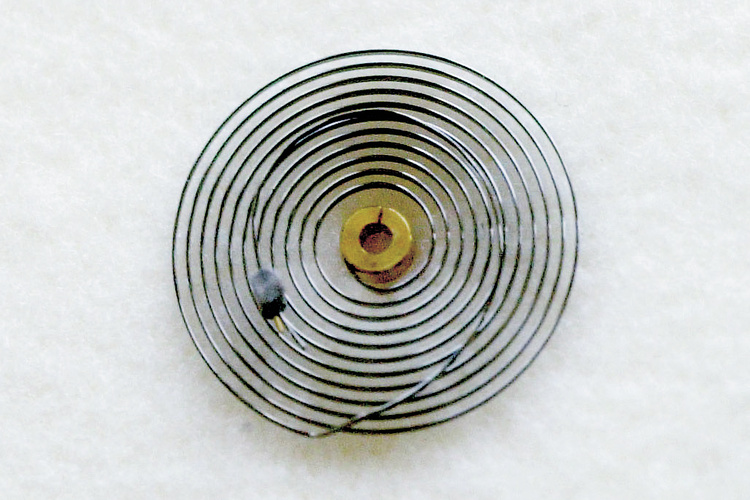
hardness
Hardness is a body’s resistance to penetration by another.
Mohs Hardness Scale, shows the score out of minerals from the following:
| Mineral | Chemical formula | Mohs hardness |
|---|---|---|
| Talc | Mg3(Si4O10/(OH)2) | 1 |
| Gypsum | CaSO42H2O | 2 |
| Calcite | CaCO3 | 3 |
| Fluorite | CaF2 | 4 |
| Apatite | Ca5((PO4)3/(F,Cl,OH)) | 5 |
| Feldspar | KAlSi3O8 | 6 |
| Quartz | SiO2 | 7 |
| Topaz | Al2(SiO4/F2) | 8 |
| Corundum | Al2O3 | 9 |
| Diamond | C | 10 |
Hardness is measured using various methods based on different scales (Vickers, Rockwell etc.). The Mohs hardness scale was often used in the past for many purposes. However, it is very imprecise, as the entire hardness range is represented by values between 1 and 10. The most common methods used today are the Vickers, Rockwell and Brinell hardness test methods. All of these are penetration methods in which a small test object (e.g. a diamond pyramid) is pressed at a defined pressure into the test surface. The hardness can then be determined from the depth or the area of the resulting impression. One of the first form of hardness mesurement was the Mohs hardness scale, a relative scratch resistance scale, devised by mineralogist Friedrich Mohs (1773 to 1839).
The Mohs hardness scale is a relative hardness scale from 1 to 10. It was specially devised to rate minerals. The scale is based on the following principle: if two minerals cannot scratch each other, they are both said to have the same hardness. If a mineral cannot be scratched by one mineral on the scale, but can be scratched by the next hardest mineral, then its Mohs hardness lies between the two hardness figures of the relevant minerals. At one end of the scale is diamond, with a value of 10, and at the other end is talcum.
The Mohs hardness scale is imprecise and non-linear in comparison to the Vickers scale. The difference in hardness between corundum and diamond is up to 8000 Vickers. On the Mohs hardness scale, however, the difference in hardness carries a value of one. By contrast, minerals with Vickers hardness levels which are much closer together, such as quartz and corundum, are separated by two points on the Mohs scale.
For this reason the Mohs hardness scale is not used for material specifications. It is, however, a useful tool for classifying minerals.
The Vickers hardness test is a common method for determining the hardness of a material. This measuring process involves pressing a small diamond pyramid into the object being tested using different loads.
The diagonal length of the resulting impressions are measured to generate an average; this figure is used to determine the hardness.
Examples of different degrees of hardness:
Stainless steel: approx. 200–240 HV
Titanium Grade 2: approx. 210 HV
Titanium Grade 5: approx. 350 HV
Hardened mineral glass: approx. 800–900 HV
Sapphire crystal glass: approx. 2,000 HV
Diamond: > 4,500–10,000 HV
Hybrid ceramic
Composite system of ceramic and polymer.
Materials such as ceramics or plastics usually have their fixed areas of application, which are linked to both the particular strengths and the processing possibilities of the respective materials. Ceramics, for example, are extremely hard, scratch-resistant and chemically resistant, while plastics can be made particularly impact-resistant and elastic and are easier to manufacture using injection moulding processes.
Hybrid materials combine the properties of different materials. A hybrid ceramic is such a composite material and has a structure in which polymers (macromolecular substances with atomic repeating units) and ceramics penetrate each other. A hybrid ceramic in the narrower sense is obtained by infiltrating a porous sintered ceramic body with a polymer under pressure and heat. In a broader sense, however, the finest ceramic powders that are bonded back into a solid material by a polymer are also regarded as hybrid ceramics. In the latter case in particular, the brittle ceramic is given some of the elasticity of a polymer and can also be processed using injection moulding technology.
Lighting elements used in watchmaking can benefit from hybrid ceramics in several ways (see Luminous colour and lighting elements).
HYDRO
Absolutely free from fogging, pressure-resistant at any accessible diving depth and perfect readability from any angle under water – these are the unbeatable advantages of our diving watches equipped with HYDRO Technology.
See Sinn Technology HYDRO.
IFR
Instrument flight rules
In aviation, there is a distinction between visual and instrument flight rules (see VFR). Visual orientation (where possible) is not avoided in practice for instrument flights. But the entire principle of this method of flight is fundamentally divorced from reference to external points (excepting take-off and landing). Instead, flight manoeuvres during instrument flights are based on the flight deck instruments and on coordination with air traffic control on the ground. A detailed flight plan must also be provided for instrument flights, which must be given to air traffic control before departure.
Due to the absence of visual orientation, instrument flights largely do not depend on weather and time of day. This is why the planned schedules of commercial flights are essentially based on IFR. There is a regulation in Europe as to which conditions require commercial flights to fly under IFR or VFR. Approval from the country-specific regulatory authority must be acquired in each individual case.
In TESTAF and DIN 8330, the demands made on wristwatches change with the flight rules. For instrument flights, a chronograph function is required in addition to the rotating bezel, which facilitates the execution of short-timed flight manoeuvres.
inhibition cycle
Correction interval in quartz movements.
A range of different techniques has been used in different developments to optimize the accuracy of quartz movements. In the past manufacturers tried to produce the quartz as precisely as possible, to grind it or to set the precise oscillation frequency by depositing layers of vaporized gold and then removing it by laser. Today, quartz crystals are ground in such a way to produce a significant gain in the movement. This gain is then measured in each individual movement at room temperature. Subsequently the movement is programmed so that the gain is corrected every one to four minutes (depending on the caliber). The movement is briefly “paused” to compensate for the gain of the quartz oscillation.
In quartz chronometer movements there is also temperature compensation. The temperature sensor on the movement plate then helps to determine the current temperature in the watch and to calculate a correction value accordingly. The correction value which is applied once the inhibition cycle is complete is therefore not constant in quartz chronometer movements; rather it is continually adjusted in line with the current movement temperature.
isochronal error
Asymmetrical oscillation of the balance.
The rotary oscillation of a balance can be described as an angle of rotation. When the watch stops, the halted position of the balance defines its home position. A (constant) isochronal error is when the rotary oscillation is not executed entirely symmetrically around the home position in all test positions, i.e. the balance oscillates to different extents in each direction. This asymmetry can be made visible using a timing machine. Isochronal error is measured in milliseconds (ms). Sinn only permits a maximum isochronal error of 0.7 ms. High-quality watches possess a special device for adjusting the isochronal error.
lines
A unit of length by which the diameter of Swiss movements has traditionally been and still is measured.
The ‘line’ as a unit of length was introduced to Swiss watchmaking as the ‘Paris line’, a French unit of measurement, for the purposes of documentation in the context of the international watch trade. It has been used as the traditional unit of measurement for movement diameters ever since.
A ‘line’ is 2.256 mm.
low pressure resistant
The compression resistance of a water-resistant watch is always related to the increased external pressure that would be experienced in the form of a column of water pressing down onto the watch case, whereas high-altitude resistance is related to reduced external pressure as encountered at high altitude above sea level. If the pressure outside the watch case falls, the difference between the pressure inside and outside the case acts as a force pushing from the inside out. Special design features have to be incorporated to ensure that the glass cannot escape from its press fit.
luminescence
Type of light radiation which is not caused by the temperature-specific thermal radiation of a body.
The sun or the coiled filament of a conventional light bulb emit light as the result of their being at a sufficiently high temperature, whereas in luminescent substances it is other processes which generate light by "cold" means. Two variations of luminescence which are of significance for technical applications are phosphorescence and fluorescence. In both cases, the "cold" radiation of light, i.e. luminescence, is caused by the incidence of an appropriate form of artificial light or sunlight. The underlying effects are closely related and can only be distinguished by referring to complex physical phenomena. However, given that phosphorescent pigments are designed to glow for longer periods (hours) whereas fluorescent pigments are not, it can be said in simple terms that daylight luminous paints are the product of fluorescence, whereas afterglow effects are basically caused by phosphorescence.
luminous paint
A coating for watch dials and hands, enabling them to be read in the dark.
In the past the main luminous paint used was radioactive tritium (³H). Today inactive luminous paints such as Superluminova are used almost exclusively. These are charged by the incidence of light and exhibit a temporary luminous effect (phosphorescence). Daylight luminous paints (fluorescence) are used in individual cases (e.g. EZM 10 TESTAF).
The luminosity time and intensity that can be perceived from luminous paint coatings depends of numerous factors. On the product-side, these include the charging status, type, and concentration, as well as the body colour of the luminous pigments, the luminous paint as well as the design-and-function-dependent surface areas and coating thicknesses. Furthermore, personal perception depends on eye sensitivity and the individual’s potential to adjust to the ambient light. Based on the large number of determinants, it is not possible to make general statements on how the temporary luminous effects of coated surfaces are subjectively perceived.
However, special attention should be paid to the colour point of the luminous pigments in our series. The body colours that we use for the luminous pigments are white, light green, ivory and black. As a general rule, dark-coloured luminous pigments produce a lower-quality temporary luminous effect (intensity and luminosity time).
For example, with the U1 series, this is demonstrated as follows:
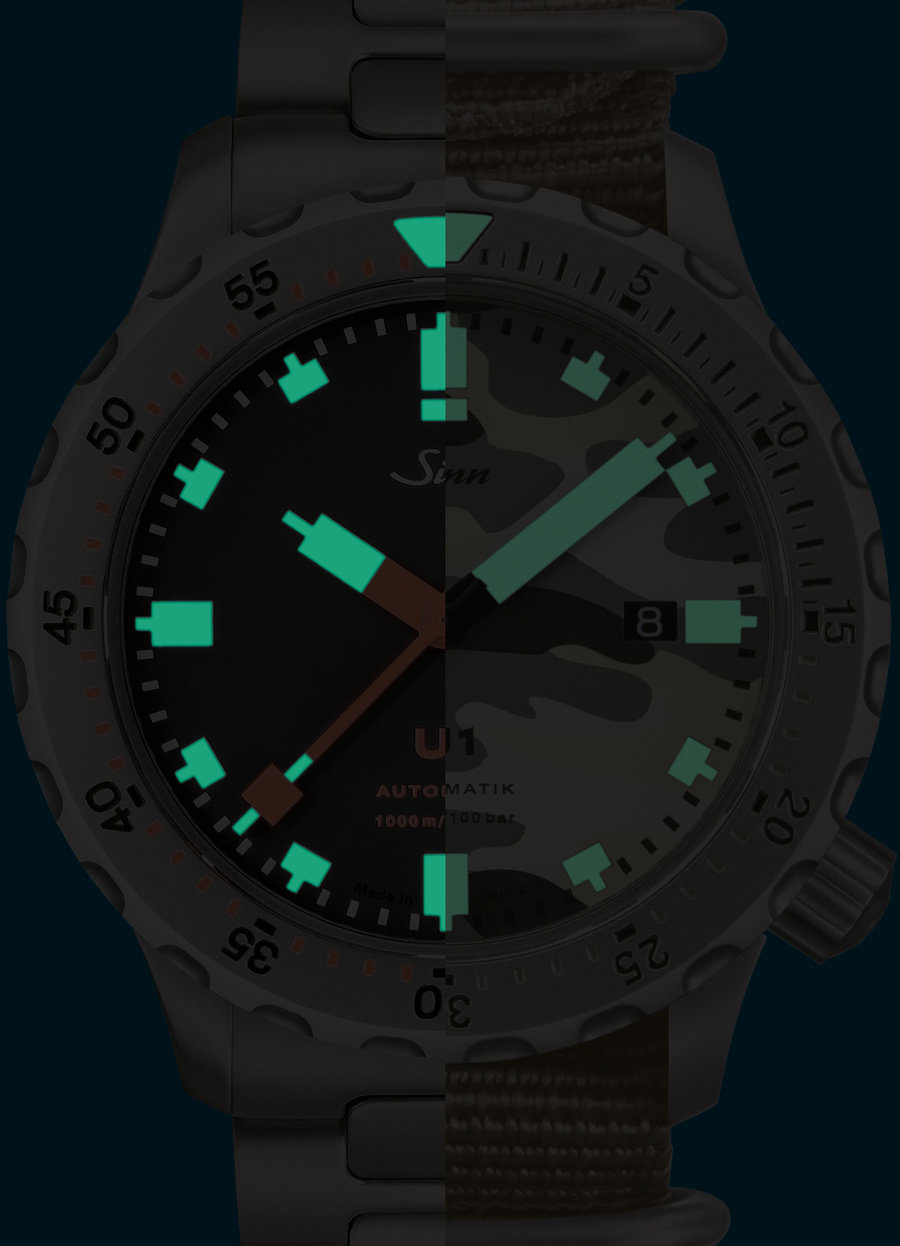
The night views shown in the SINN online shop show neither the light intensity nor the exact colouring. They are simply intended to illustrate those parts of the watch which are coated with luminescent colour.
Magnetic Field Protection
Watch case which shields against magnetic fields. See Sinn Technology Magnetic Field Protection.
magnetism
Forces which can commonly be observed in the form of magnetized objects attracting and repelling each other. Possible source of interference in a watch’s action.
Magnetic fields are encountered with ever-increasing frequency in our environment. Whereas the Earth’s magnetic field does not constitute a risk, magnetic fields from loudspeakers, door closers, locks etc. can have a lasting effect on the action of a mechanical watch. In a survey of almost 1000 watches carried out by SINN’s customer service department, roughly 60% of these proved to be magnetized, and half of these, i.e. 30% of the total, exhibited strong magnetic field errors. In some cases the accuracy errors could be corrected by demagnetizing them.
The main source of magnetic field errors lies in a magnetized Nivarox hairspring, i.e. the timing organ of the watch. Nivarox hairsprings are far superior to older steel springs with regard to magnetic field sensitivity, as Nivarox springs are antimagnetic (DIN 8309). However this requirement permits an error margin of +/- 30 seconds per day under exposure to relatively weak magnetic fields. This, though, is not compatible with chronometer standards.
Mission Timer
Mission Timers (Einsatzzeitmesser or EZM) are watches which have been specially developed for a particular purpose. They always offer excellent readability. This means: the form is always dictated by the function and handling requirements.
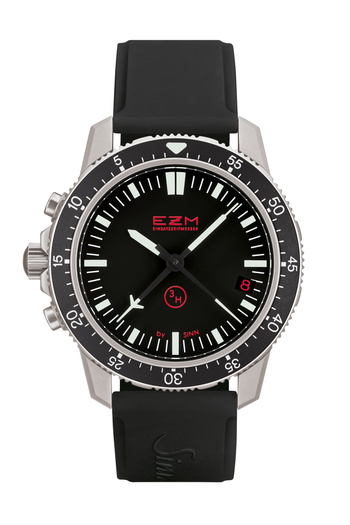
NaBo
Sinn trademark, standing for navigation cockpit clocks. Navigation cockpit clocks are intended for installation in aircraft cockpits.
nickel
Chemical element: a hard, silver-white metal obtained primarily from magnetic pyrites.
Nickel is an important alloy component in many types of steel. The nickel content in these is between 9 and 18%. Nickel steel is exceptionally hard and robust. It is used for tools and for military purposes (armor plate, gun barrels). Combined with chromium it produces highly corrosion-resistant chromium-nickel steel. Some people have an allergic reaction to it if it comes in contact with their skin.
nickel silver (ARCAP)
An alloy made of copper, nickel and zinc.
This material has been dubbed ‘nickel silver’ due to its silvery appearance. It does not contain any silver, but has been purposely developed to look like silver.
Nickel silver is an excellent material, characterised by high strength and corrosion resistance. It is traditionally used to make instruments, cutlery and precision equipment.
nickel-free metals and nickel release
Euro standard 1811 was implemented in German law in 2000, aimed at avoiding nickel allergies. This standard defines and regulates nickel release.
Nickel release is basically a measure of the release of nickel into the skin. The emission of nickel can result in allergic reactions. The standard stipulates that no more than 0.5 µg of nickel may be released per square centimeter of skin per week. This limit may not be exceeded by any product coming into direct and long-term contact with the skin.
The level of nickel release is not determined by the nickel content of a metal, rather by its corrosion resistance. Only through corrosion processes can nickel escape from a steel alloy in the form of ions or complexes. In highly corrosion-resistant steel, the nickel therefore remains stably bonded in the steel even if it has a relatively high nickel content. For example, stainless steel containing nickel (content 12.5% to 15%) is used even in medical implants, without any allergic reactions being observed. At Sinn we also use this same grade of steel (DIN 1.4435). Its nickel release is 50 times lower than the value prescribed by EURO standard 1811. This corresponds to 2%.
There are also grades of steel with a residual nickel content of less than 0.2%. This, however, is merely the impurity traces of nickel measurable in all types of stainless steel and not an alloy component. In this case and also in the case of special case backs offered by Sinn, we therefore refer to nickel-free steel although strictly speaking it is non-nickel-alloyed steel.
Nivarox
Metallic alloy used to make superfine hairsprings.
This alloy solves to a great extent the problem of temperature-related changes to the elasticity and length of the hairspring and the balance. As the temperature rises, a metallic spring generally becomes softer and longer; the diameter of a metallic ring (balance) also increases slightly. However, such a change in the material characteristics would cause the balance to oscillate more slowly, and therefore the watch to lose time. Nivarox is the name (derived from the German terms for "non-variable" and "oxide-resistant") of the most common type of alloy used to make temperature-compensating (or auto-compensating) hairsprings. This material solves the problem of temperature sensitivity in two ways. Firstly a Nivarox spring only changes its length and elasticity to a relatively small extent within the temperature range stipulated by the chronometer norms. Secondly, the remaining temperature effect is compensated by processes inside the spring itself (hence the term "auto-compensating"). These compensatory processes stem from the magneto-strictive properties of nickel – an element which appears in Nivarox springs as an alloy component.
Magneto-strictive interaction takes place in certain conditions in (ferro-) magnetic objects. Such objects have an internal magnetic field structure which is not necessarily apparent as an external magnetic field, as the internal fields of the magnetic domains (Weiss domains) cancel each other out. The objects are therefore in a constant state of internal magnetization. What is decisive is that the predominant magnetic field structure depends on the temperature of the object and that a change in this structure due to magneto-strictive interaction causes elastic tension in the object, i.e. deforms it, which then neutralizes this tension.
However, the basic principle of this temperature compensation – the use of ferromagnetic materials – leads to susceptibility to external magnetic field influences, as other magnetic fields can of course change the magnetization status of the spring, and hence its elasticity, in addition to the temperature. This can cause considerable rate deviations up to and including complete stoppage of the watch (see magnetism).
non-magnetic
Unsusceptible to the influence of magnetic fields up to a defined strength.
Strictly speaking, no material is completely unaffected by magnetic fields. Materials or objects are described as non-magnetic if they react so minimally to magnetic fields that sensitive instruments are needed in order to detect any effect. For all practical purposes, materials such as glass or some types of steel can be rated non-magnetic.
orientation pointer
The 24-hour pointer, shaped in the form of an arrow, is intended to help calculate the compass direction.
When the current position of the sun is visible, a 24-hour pointer, which runs synchronously with the 12-hour hand, makes it easier to determine the approximate direction. In the Northern hemisphere, if the dial is oriented horizontally and the watch turned so that the 12-hour hand (ignoring daylight savings time!) points to the sun, then the 24-hour pointer will point North. In the Southern hemisphere, North and South should be exchanged.
It should be borne in mind that, depending on the time of year and the parallel and meridian, the calculated geographical North may deviate by up to 25°.
ornamental movements
Decoratively refined movement, e.g. featuring ornamental grinding, mirror finish, engraving, galvanic surface refinement or special components.
Regardless of its technical design quality, the aesthetic appeal of any movement can be enhanced through various decorative features. Bridges and plates offer scope for engraving or skeletonisation and can also be given ornamental grinding features (e.g. sun, stripes or clouds).
Instead of conventional nickel-plating of the brass bridges and plates, a galvanic rhodium coating (a metal from the platinum group) or a colouring metal compound can be applied. Screw heads can be polished, varnished blue or turned blue through tempering. Simple edges can be transformed through angling (to create a chamfer). Milled ring grooves around visible bearing jewels create the impression of a bearing lining (Chaton) in places where the gold-coloured substrate is exposed in a rhodium-plated bridge.
phosphorescence
The luminescence phenomenon upon which afterglow luminous paints are based.
Ordinary paints reflect some of the sunlight or artificial light falling upon them, making them visible to the human eye. The luminous pigments in phosphorescent paints are charged up by being exposed to light; they then function themselves as a light source for several hours afterwards. This effect is used, for example, to highlight escape routes in buildings during a power failure or to ensure that watch dials or numerals can be read in the dark. Phosphorescence is not based on radioactivity. The materials used are non-toxic and, in contrast to radioactive luminous paints, do not lose their ability to glow even after longer periods of time. The afterglow luminous paints we use are supplied by Superluminova. These have been specially developed for use in watches and their length of afterglow and intensity are constantly being improved.
pilot watches
The term ‘pilot watch’ is used in literature and by watch manufacturers in an inconsistent and unclear way. The general understanding is that a pilot watch is characterised by certain traditional design features such as a black-and-white dial with a striking, triangular 12 o’clock marking.
At SINN, too, we provide the clearest possible readability for pilot watches. In addition, the sapphire crystal watch glass in all SINN pilot watches must be capable of withstanding negative pressure of up to 0.2 bar. This corresponds to a flying altitude of approx. 12,000 metres.
Together with SINN, the flight lab at Aachen University of Applied Sciences launched a technical standard (TESTAF) for the professional use of wristwatches in aviation, which contains a precise list of requirements and sets out an appropriate certification procedure.
The first watches to be TESTAF-certified were the SINN chronographs EZM10 TESTAF, 103 Ti UTC TESTAF, 103 Ti TESTAF. The pilot watches 857 UTC TESTAF and 857 UTC TESTAF LH Cargo followed in 2013, and the EZM 9 TESTAF in 2014.
Pilot's bezel
Generally a rotating bezel that can be rotated on both sides and typically engages to the minute.
In addition to the main marking, a clockwise or anti-clockwise minute division (countdown) can be applied. Within the framework of TESTAF and DIN 8330, a rotating bezel that can be rotated on both sides with at least one luminescent marking is mandatory for flight operations in accordance with both visual flight rules and instrument flight rules. The minute-by-minute detent must also provide tactile feedback. A standardised pilot's rotating bezel must be operable with gloves typical for flight operations.
pilot’s bezel
A bezel that is generally rotatable in two directions and may have minute ratcheting.
In addition to the main markings, a minute scale may be applied either clockwise or anticlockwise (count-down numbering). A pilot’s bezel should be operable whilst wearing gloves. For TESTAF, a bezel rotatable in two directions with at least one luminescent marker is compulsory both for visual flight rules aviation as well as instrument flight rules aviation.
Powder-metallurgical production processes
Processes used to manufacture metallic finished components or blanks, whereby metal powder and a mould is used instead of solid material.
Normally, the production of metal components involves machining semi-finished products such as solid poles or plates. The end product is gradually carved out of these raw materials using milling machines and lathes.
In a powder-metallurgical process, on the other hand, the raw material is a fine powder (or powder mixture made up of different metallic components). The typical grain size is less than 0.5 mm. First of all, the powder is pressed into a mould and compressed at such high pressure that the grains fuse together and usually also – due to the intense friction between them – undergo cold welding. A so-called ‘green compact’ is formed, which is still visibly grainy in texture. At the second stage, the green compact undergoes a sintering process. It is heated until it is close to melting point. Wherever the grains touch, the diffusion of metal atoms creates a permanent bond between the grains.
Finally, the remaining porosity in the work piece can be eliminated either by hot isostatic pressing, by immersion in molten metal or by hot rolling.
The process is particularly suitable for producing moulded parts from hard metal (where the level of resistance is too high for turning and milling). In our 1800 S Damascus model, the process is used to create steel strips out of stainless Damascus steel. The steel qualities necessary for corrosion resistance can withstand the traditional process of folding and forge-welding.
pressure-resistance
According to DIN, the pressure resistance of a water-resistant watch describes the pressure load which a watch can withstand.
In Sinn watches, the pressure resistance is generally given in bar or in diving-depth meters. One bar of pressure corresponds to the static pressure of a 10-meter head of water.
pulsimeter scale
The pulsimeter or respiration scale is a scale with a base of 15. It permits pulse or breathing rates to be read off after stopping the time required for 15 pulses or breaths. For example: 15 heartbeats in ten seconds equals a pulse rate of 90 beats per minute; or 15 breaths in 36 seconds represents a respiration rate of 25 breaths per minute. This procedure can also be used to determine other units on a per-minute basis. Simply measure the time needed for 15 units, and then read off the units per minute.
Combination of a tachymeter/pulsometer scale on a 144 St DIAPAL watch
Pulsrotor
Pulsrotor
A registered trademark of Sinn Spezialuhren which refers to a uniquely shaped second display.
In the case of the EZM 12 model – the mission timer developed in collaboration with the emergency doctors of the air rescue team –
the pulse rotor display features a four-arm second hand.
The rotor blades of a helicopter served as the inspiration for the design. The cross-shaped arrangement of the four hand elements facilitates faster, hands-free checking of a pulse. You can begin checking a pulse every 15 seconds using the central second hand of the 12-hour index without the need for hands and without activating a watch control.
PVD
PVD (Physical Vapour Deposition) refers to a group of processes used to apply thin layers of hard material to an object. The coating material is initially provided as a solid. It is then vaporized or atomized and subsequently deposited on the substrate, with no change to its chemical composition. The main advantage of PVD lies in their relatively low deposition temperatures. This permits a wide range of materials to be used for coating.
The surface hardness of PVD coats is 2000 to 3000 HV, depending on the type of coating. It is therefore significantly higher than that of galvanically applied chrome plating. The possible coat thicknesses start at the nanometer level and can be built up to several micrometers.
A negative effect arises if such thin hard material coats are applied to untempered materials such as stainless steel or titanium (180 to 220 HV). Knocks and scratches give rise to the so-called eggshell effect on account of the difference in hardness between the hard material coat and the base material. The coating collapses, exposing the different color of the material beneath.
At Sinn we only use hard material coats in combination with TEGIMENT for this reason. TEGIMENT has a hardness of approx. 1200 HV and merges gradually, and not suddenly, into the hardness of the case stainless steel itself. This avoids the eggshell effect.
Quartz watch
Watch equipped with a quartz movement.
Quartz watches were developed and built for the first time in the first quarter of the 20th century. Based on a more affordable production technology, they conquered the market in the late 1970s.
While you can actually observe the clockwork mechanism of a watch in action, the function of a quartz watch is based on electronic processes which, for the most part, are not directly visible. While the physical oscillation of the timepiece is also visible in the centre of the quartz movement – that is, the oscillating crystal – this oscillation is so slight and so fast that it is invisible to the naked eye. What’s more, the oscillating crystal is positioned inside a capsule, which allows it to oscillate shielded in a protective gas.
The basic principle behind quartz oscillation is the (inverse) piezo effect, which refers to the visible formation of crystals in many materials following the application of an electric charge. Inside the movement, such a piezoelectric element is integrated into an electronic oscillator, which generally operates at a frequency of just over 32,000 Hz. Through continued frequency division, the second interval is derived from this high frequency, ultimately actuating the stepper motor. In the case of analogue quartz watches, the stepper motor generates the typical jerking movement of the second hand using the gear train.
Due to their high frequency, quartz movements are much more precise than mechanical movements. Unlike temperature-compensated chronometer movements, conventional movements demonstrate a deviation of a few seconds per week. They are dependent on electrical energy to function. This energy supply is usually guaranteed for approx. 2 years with the most common button cells. As with mechanical movements, however, there are special designs of quartz movements that draw their energy from a barrel or an oscillating weight. Lithium batteries and particularly energy-saving motors also provide significantly longer lifetimes. Our UX and U50 HYDRO models are each equipped with at least one of these measures.
Complications, chronographs and perpetual calendars can be incorporated into quartz watches without much effort, as the corresponding displays are powered by separate motors and the associated controls are easy to program using the integrated circuits.
regulation
The stages involved in achieving that highest possible degree of accuracy in a watch.
Even though the production quality of toothed wheels, bearings and pivots is decisive for the stable running of a watch, these manufacturing stages are not generally regarded as part of the regulation system.
However, the regulator correction at the end of the regulation process, which is often the most visible aspect of regulation, can only succeed as part of a good overall regulation process.
Regulation is an adjustment procedure carried out in four stages: centering the hairspring, adjusting the escapement, truing the balance, adjusting the regulator.
Regulation can cover both the different test positions and also temperatures. This is required in particular in the regulation of a chronometer.
regulator correction
A device used to set the rate of a watch.
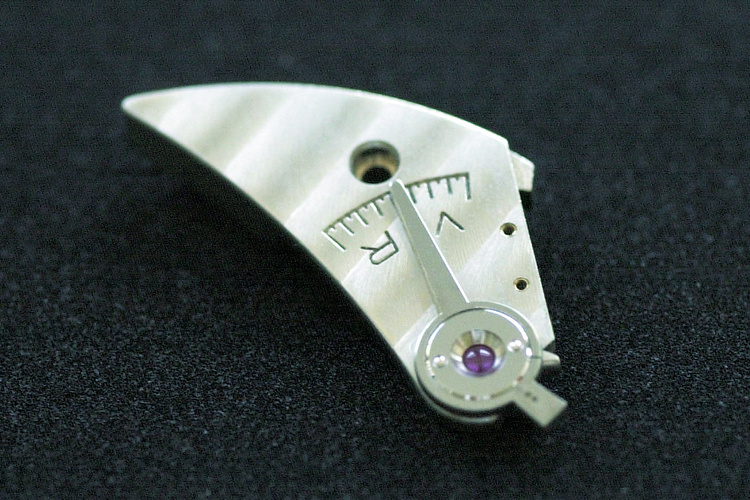
A regulator correction changes the effective spring length of the oscillation system’s hairspring. Before the hairspring hits its outer fixture point it passes through a gap formed by two adjacent pins. The part of the spring between the gap and the outer fixture point is exempted from the free oscillation of the spring. If the position of the gap is shifted by a regulator correction, this changes the active spring length. Depending on the direction of the change, the watch then runs faster or slower.
Rhodium
A chemical element belonging to the group of platinum metals.
Rhodium is a precious metal that is difficult to extract, and is comparable to platinum in many respects. Jewellery designers often use rhodium to give white-gold alloys a decorative finish.
The surface of the relief dial of our 1746 Heimat is rhodium-plated, which gives it a bright, silvery sheen.
sapphire crystal
Watch glass made from artificially produced sapphire crystal. Sapphire crystal consists of monocrystalline aluminum oxide (Al2O3). At 2000 HV on the Vickers hardness scale, it is a scratch-resistant watch glass. It is also considerably more scratch-resistant than mineral glass.
sapphire crystal, domed
A specialty of high-quality watchmaking.
On account of its exceptional hardness, sapphire crystal is the material of choice for high quality watch glasses. Watch glass made of sapphire crystal is significantly more difficult to manufacture than mineral or synthetic glass.
A total of up to five different radii of curvature are created for our domed sapphire crystals by means of elaborate cutting and grinding processes – a special feature which is contrasted here briefly with conventional glass forms.
The final form of flat sapphire crystal is not too different from that of its original raw state. These watch glasses can be cut directly from a cylinder and then polished.
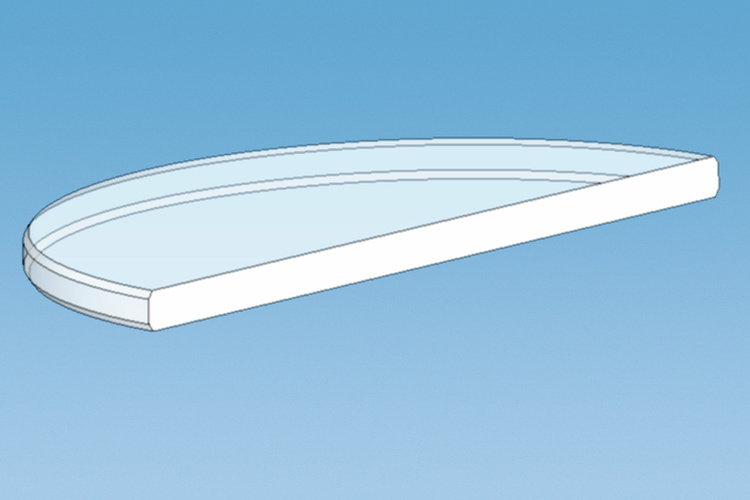
The blank of a single-dome sapphire crystal watch glass needs to be thicker than the final glass thickness. However, the final shape of the crystal is only formed from a single dome radius, meaning that the grinding process is still relatively simple.
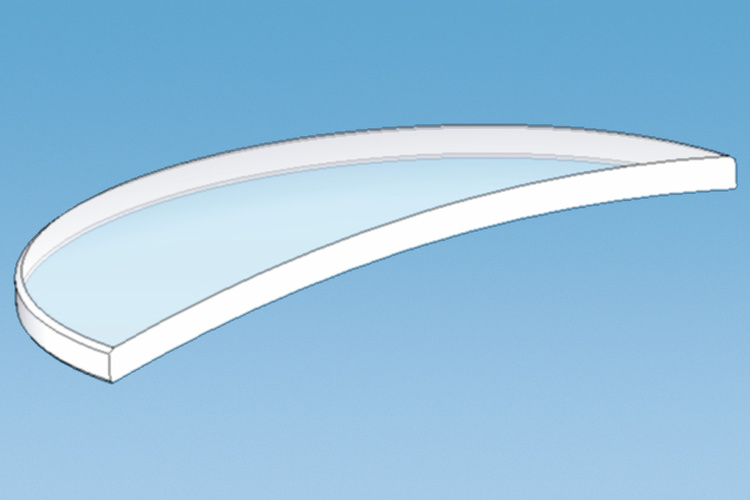
A domed sapphire crystal watch glass for our series 356 and 358 recreates the form of the acrylic glass, using five different curvature radii. For this reason, grinding tools which have been specially made for the specified radii are needed to create the inner and outer form of the dome.
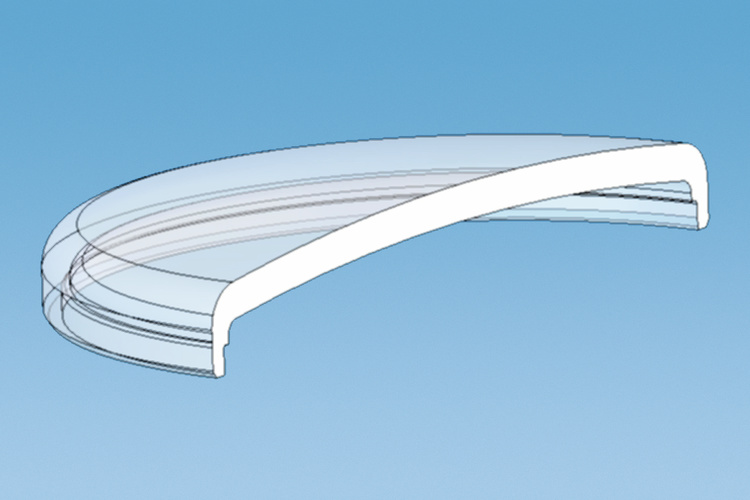
The thickness of the sapphire crystal glass blank for our series 356 and 358 is roughly 5 mm, i.e. it is much thicker than the blank for a conventional flat glass. The final shape must first be ground out of this blank and then carefully polished.
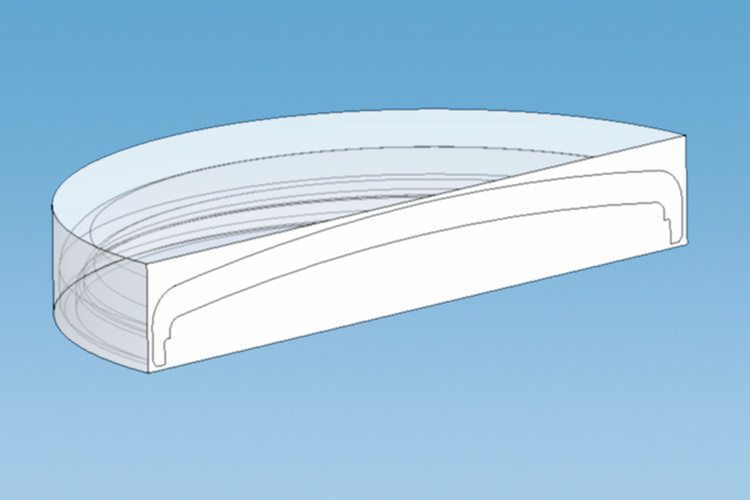
seconds stop function
Device to stop the watch movement, allows precise setting of the time.
The seconds stop function needs to be distinguished from the stopwatch second function. The stopwatch second function is operated by pressing a push-piece; this allows times to be stopped using a separate display without having to lose the current time as a result. This function is reserved exclusively for chronograph movements. The seconds stop, by contrast, is also incorporated in three-hand movement watches (hours, minutes, seconds) and is triggered by pulling the crown into the setting position. A lever mechanism linked to the crown arrests the balance oscillation right at the balance wheel, stopping the movement immediately. Once the hands have been adjusted, the watch can then be restarted with split-second accuracy using a reference time signal.
shock resistance
As of mid-2017, watches must meet the requirements of the DIN ISO 1413 standard to obtain the ‘shock-resistant’ label. The former DIN 8308 standard is therefore no longer applicable.
The DIN ISO 1413 standard expands on the DIN 8308 requirements and tightens some of the test criteria. It represents a continuation of the fundamental concept that a fall from a height of 1 metre onto a hard wooden floor should not damage the function of a shock-resistant wristwatch and that any resulting change in the watch rate should not exceed +/–60 seconds per day.
Like its predecessor, the DIN 8308 standard, the DIN ISO 1413 standard simulates the conditions of the free fall with a hammer blow at a specified speed and with certain material specifications, so that the test can be conducted under clearly defined, repeatable conditions.
Key new aspects of the DIN ISO 1413 standard are attention to hand position and the introduction of an additional shock to the crown.
Sinn sealing grease 30-288
Fully synthetic grease developed especially for SINN for use on seal rings at temperatures ranging between -45°C and +80°C. A seal ring treated with this grease has a considerably lower gas permeability rate than an ungreased ring at the same compression and temperature. It also increases the ageing resistance of the seals.
The performance of EDR seals is optimized through the use of Sinn sealing grease 30-288. This combination gives Sinn watches significantly greater protection against humidity than any conventionally sealed watch.
Sinn special oil 66-228
High-grade, fully synthetic oil specially developed for Sinn. Its outstanding properties at low and high temperatures allow the watch to run accurately from -45°C to +80°C.
slide-rule scale
The slide-rule scale works on the principle of logarithmic scale divisions. This allows you to multiply and divide numbers. It is useful for calculating consumption, converting units and currencies and for all kinds of rule-of-three calculations. Additional information about the slide-rule function of the 903 model series.
split-seconds hand
An additional second hand on a stopwatch/chronograph for recording intermediate times.
With a split-seconds chronograph (also called a rattrapante), two second hands are set in motion when the start button is pressed. The specific split-seconds function now makes it possible to stop the second stopwatch hand (the ‘carried’ hand) separately, without affecting the movement of the other second hand. In this way, an intermediate time can be recorded. The split-seconds hand can be re-synchronised with the first second hand by pressing the intermediate stop button again.
Our 910 Anniversary model features this special function.
SRS
An abbreviation used to indicate a fly-back function on SINN chronographs.
Pilots or athletes are often faced with the challenge of measuring or specifying the lengths of several immediately consecutive time intervals separately (i.e. not aggregating them). A pilot may have to fly in a certain direction for 20 seconds and then change course for 45 seconds, for example. To accomplish this measuring task with a normal chronograph, they would have to stop the time measurement after 20 seconds, reset the timer to zero and start measuring 45 seconds from scratch. This not only means pushing a button three times, which is quite laborious, it also creates a gap between the end of the first and start of the second measurement that is equivalent to the length of time taken to push said button. By contrast, the SRS function means you can push the reset button to trigger all three functions at once – stop the current measurement, reset the timer and start the new measurement. In visual terms, this specifically means that pressing the button once resets the running second stopwatch hand to zero without interrupting the measurement. People also talk about a ‘reset in flight’, from which the traditional term ‘flyback’ is derived.
Our 910 SRS is equipped with this function.
stainless steel
Stainless steel is a grade of steel with a very high degree of purity and a chemical composition defined within narrow tolerances.
Of particular importance in watchmaking are corrosion-resistant stainless steels, i.e. types of steel which are protected from corrosion.
As a special feature we use submarine steel which is distinguished by its resistance to seawater and its premium non-magnetic qualities.
submarine steel
Special grade of steel developed by ThyssenKrupp for the outer shells of the very latest non-nuclear submarines, the 212 class, of the German navy.
Our U series diving watches cases are made entirely from this special grade of steel.
This material is 100% austenitic steel; it is exceptionally strong and has superior non-magnetic properties. Its mechanical strength is more than 1.55 times that of the usual watch case steel AISI 316L.
A further advantage of using this steel in the manufacture of diving watches lies in its unique saltwater resistance. Normal case steel has to be rinsed in fresh water after contact with saltwater, as long-term exposure to saltwater can, in adverse circumstances, lead to corrosion. Submarine steel, by contrast, is completely resistant to prolonged contact with saltwater. Also, submarine steel is, on account of its ductility, extremely resistant to cracking, thereby further increasing its reliability.
SUG
Acronym for SÄCHSISCHE UHREN-TECHNOLOGIE GMBH GLASHÜTTE.
SUG is a manufacturer of high-grade watch cases. In 2001 SUG was the first, and to date the only, German watch case manufacturer to be awarded DIN EN ISO 9002 certification.
This standard requires exacting quality management based on the use of suitable test methods and full traceability of all procured materials.
Most of the outstanding watch cases made for Sinn are manufactured by SUG in Glashütte in Saxony and carry the SUG inscription.
superluminova
Luminous paint for dials and hands, belonging to the group of inactive luminous paints, i.e. it emits no radiation. The luminous effect is based on the principle of phosphorescence.
Superluminova therefore needs to be charged by an external light source. In order to exploit the maximum luminous capacity of the paint pigments, the paint must first be fully activated. In direct sunlight this takes roughly 90 minutes. Superluminova can be charged and discharged as often as required without losing any of its charging capacity. A further advantage in comparison to tritium-based radioluminescent paint is that it does not turn gray or yellow with age.
SZ01
The SZ01 movement has been specially developed by SINN. The development work began back in 2003.
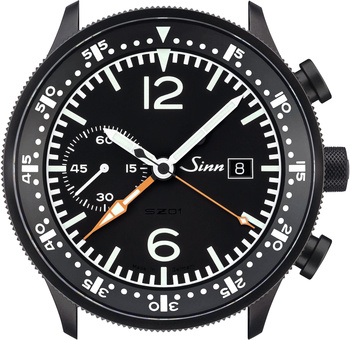
The main priority in undertaking the redesign was to make the chronograph functions significantly easier to read off. Which is why we attached so much importance to finding a first-class technical solution to mounting the jump 60-minute stopwatch hand in the centre of the dial. This allows users to take accurate stop times even more quickly and simply. The clarity and distinct readability of this chronograph stem from the design of the well-known Lemania 5100 movement.
Our redesign enhances the readability in two ways: firstly, 60 minutes are now counted in one sweep of the hand instead of the usual 30 minutes, and secondly, the minute stop scale covers the entire diameter of the dial.
SZ02
The SZ caliber 02 is a in-house modification of the SZ01 movement, characterized by an off-center 60-minute counter.
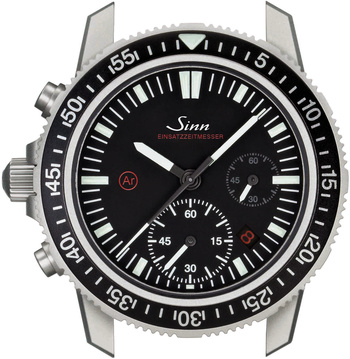
Usually, the counting minute of the chronograph function only has a 30-minute counter. Stopped times are difficult to see on these standard calibers as the interim marks of the hour counter are very close to the hour indices. Only with the aid of this pointer is it possible to distinguish between a minute display of 0 to 30 and 30 to 60. The SZ02 permits direct reading of the minutes right through from 0 to 60 minutes.
The SZ02 was launched in 2006, the year of the World Cup in Germany. It was housed in the case of the 303 football chronograph. The caliber has more than proved its worth since then, forming a reliable base for the perfect readability of the diving watch EZM 13.1.
SZ03
The SZ03 is developed by Sinn and is characterised by a calendar week display at six o’clock.
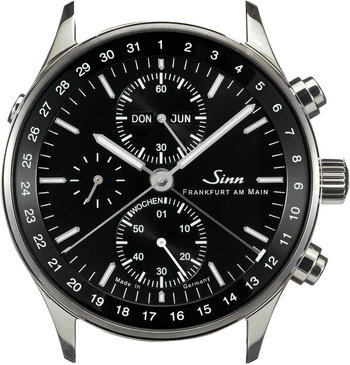
The movement also features a 60-minute counter. This replaces the 30-minute counter – which is characteristic of the standard movement – and is positioned off-centre at 12 o’clock, just like SINN’s own chronograph rebuild, the SZ02.
In addition, the movement displays the date, the day of the week and the month.
To enable intuitive reading of the calendar week at a glance, the week display is now featured alongside a 60-minute display in the SZ03.
SZ04
Sinn’s own rebuild of the Unitas 6498 pocket watch caliber into a movement with regulator display.
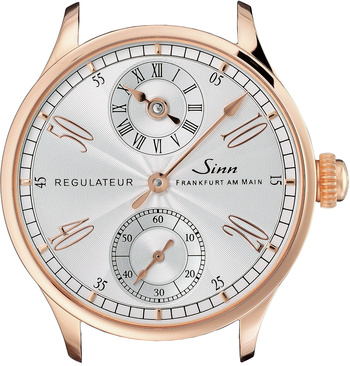
A regulator pointer recalls a feature found in precision grandfather clocks, which have a large-diameter fine-minutes dial for regulatory or monitoring purposes. For reasons of better readability in the minute hand, this features small, off-center hour and second dials.
Sinn has moved the hour dial from the center towards 12 o’clock, without causing any additional friction losses or using additional gearing. The Unitas 6498 caliber already had a small seconds dial, and the SZ04 represents the optimum horological solution of a regulator display with three separately positioned dials for hours, minutes and seconds.
SZ05
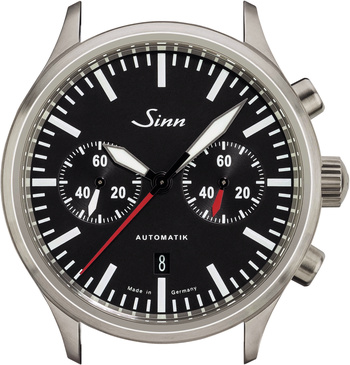
The purpose of the in-house movement redesign was to significantly increase the clarity and readability of the dial display. To this end, in designing the SZ05 we focused on a stopwatch minute display with a 60-minute scale at 3 o’clock and a running second hand at 9 o’clock. This does away with the annoying necessity of adding stopwatch minutes as required with conventional 30-minute stopwatch displays.
SZ06
The SZ06 is a chronograph developed by SINN.
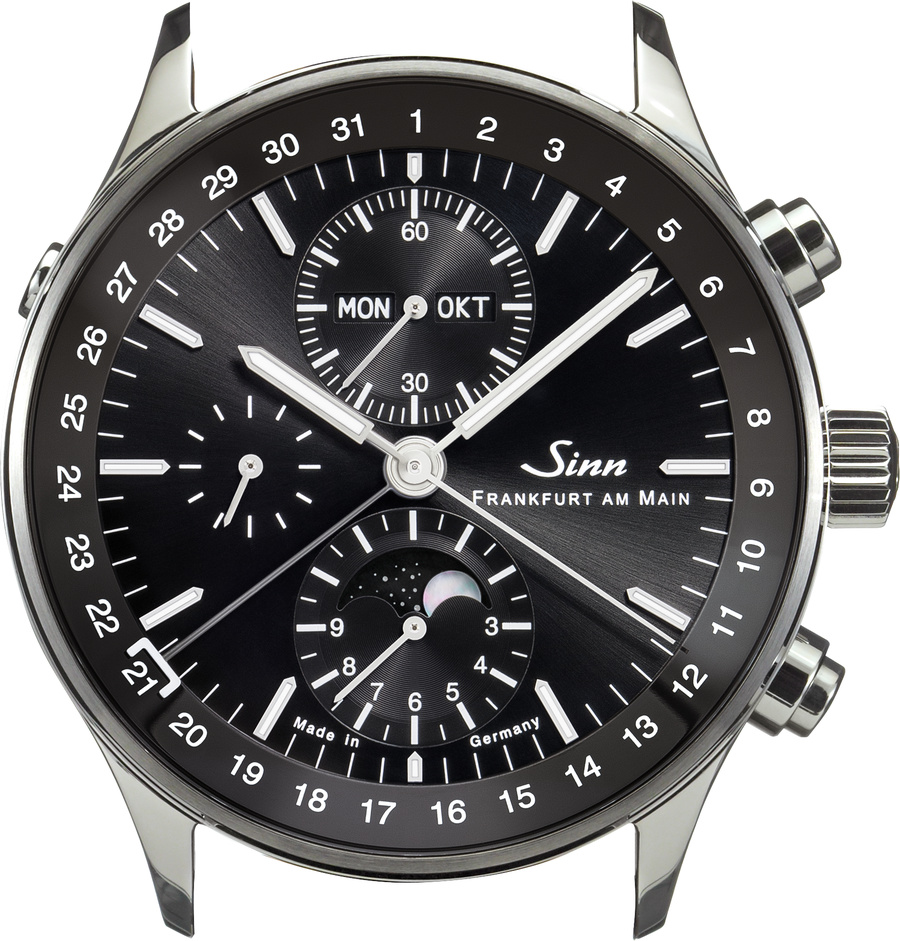
It combines the decentralised 60-minute counter (SZ02) with a moon-phase indicator and a full calendar.
tachymeter scale
The tachymeter scale permits an average speed to be measured over a distance of one kilometer. For this, the stop-watch function must be activated at the start and end of the distance. Miles per hour (mph) can also be measured using the tachymeter scale and the same principle.
A tachymeter scale shown on a 956 Classic watch.
TEGIMENT
SINN trademark for stainless steel and titanium surfaces with a particularly high level of hardness and scratch resistance. SINN watches featuring this technology have been labelled with the TEGIMENT logotype since 2008. See SINN Technology TEGIMENT.
temperature compensation
Temperature compensation refers to devices or combinations of materials which keep temperature-related fluctuations to a minimum.
The physical timer processes at the heart of a timepiece movement are subject to temperature fluctuations. For example, when warm, the pendulum of a large clock becomes elongated, extending the duration of the oscillation. The rotational oscillation of a balance also changes its frequency due to temperature fluctuations, as the length of the hairspring, the circumference of the balance wheel and the elasticity of the spring are all temperature-sensitive.
In the past, bi-metallic designs were common in pendulums and also in balance wheels. Two metals with different thermal expansion coefficients were combined so that two contradictory expansion effects cancelled each other out in temperature fluctuations.
In modern mechanical wristwatches, the temperature is compensated for with the use of springs made from Nivarox. By contrast, a temperature sensor is used in high-quality quartz movements (chronometer quality) – such as the ones used in our UX series diving watches and our 434 series women’s watches. The correction value of the quartz oscillation is constantly adjusted in its inhibition cycle in line with the measured temperature. For this technology, the daily average accuracy is between +/–0.07 seconds per day at 23°C, and within a range of +/–0.20 seconds per day at both 8°C and 38°C. The stability of the running accuracy at a set temperature is limited to 0.05 seconds, making this type of movement around 20 times more accurate than a quartz movement adjusted to room temperature without temperature compensation.
TESTAF
TESTAF is an acronym for ‘Technischer Standard Fliegeruhren’ (technical standard for pilot watches), a list of requirements and the creation of a certification body for watches launched by the Department of Aerospace Technology at Aachen University of Applied Sciences together with Sinn Spezialuhren which is used in professional aviation operations.
TESTAF
Technischer Standard
Fliegeruhren
The role of a watch as part of contemporary aviation is barely different from the role of the diving watch in diving when it comes to issues of safety. In both cases, diving computers or on-board instruments are the main means of measuring time. However, wristwatches are commonly used as backup devices which enable the execution of the flight or dive in accordance with prescribed procedure or emergency termination in the case of primary equipment failure. Despite these similarities, DIN 8306 does provide a standardisation of the term ‘diving watch’, but there is not yet a similar regulation of the term ‘pilot watch’. TESTAF closed this loophole initially in the form of a technical standard, which stipulates all the key requirements that a wristwatch as a backup instrument should meet in modern aviation. It also developed the first standard for testing and certifying such a pilot watch with an extensive series of tests.At the suggestion and with the help of Sinn Spezialuhren, TESTAF was used shortly after its completion by the German Institute for Standardisation as a basis on which to develop a standard for pilot watches (DIN 8330-1/8330-2) for the first time. TESTAF can be viewed or downloaded free of charge at www.testaf.org.
Distribution of the DIN standard is strictly prohibited by copyright law. The standard may only be purchased from the Beuth Verlag publishing house as a document for download or in paper form.
titanium
Sinn only uses titanium grade 2 and titanium grade 5, which is an ideal material for wristwatches.
No allergic reactions are known. With a specific weight of roughly 4.5 g/ccm it has just 60% of the weight of stainless steel (specific weight approximately 7.8 g/ccm). It quickly absorbs body heat as a result of its low specific thermal capacity and its low thermal conductivity. This makes it comfortable to wear, particularly during the cold months of the year. The low electrical conductivity of titanium also increases wearing comfort as it reduces the electrical voltage compensation between different parts of the skin around the wrist.
Grade 2 titanium: pure titanium with the material number 3.7035.
Grade 5 titanium: a high-strength titanium alloy with the material number 3.7165.
triovis precision adjustment system
A sophisticated system for speed adjustment of a movement.
The exact speed setting of a movement can often not be carried out with the desired precision by means of direct regulator correction. The Triovis system is one of the precision adjustment systems with which the speed setting on a watch can be optimised. For this purpose, the regulator disc is fitted with a very fine outer toothing which interlocks with an equally fine set screw. The regulator disc can thus be moved via the rotation of a set screw. This is advantageous in both the permanent fixing of a regulator’s position and in the precision of the adjustment, as the breakaway torque typical of the regulator is mostly eliminated.
tritium
A radioactive luminous paint for dials and hands.
Tritium is an isotope of hydrogen (³H), a volatile gas. It is slightly radioactive and has a half-life of 12.3 years.
Luminous paint which is energised by tritium does not need to be charged by external light. The volatile gas is bonded in a polymer (tritiated plastic). With its electron radiation, it energises a passive luminous substance such as zinc sulphide, causing it to emit visible light.
The radioactivity emanating from the tritium coating in a water-resistant watch covered with a sapphire crystal is not detectable. Luminous paints containing radioactive tritium are completely harmless to wearers of watches.
UTC
Universal Time Coordinated (UTC) = coordinated world time, since 1975 (15th General Conference on Weights and Measures) the basis both for legal time and also for scientific-technical applications in astronomy, navigation and electronic communication.
The UTC scale is not an astronomically based time, rather it is calculated from the coordination of roughly 250 atomic clocks worldwide. The irregular rotation of the Earth results in small discrepancies to GMT using this definition.
However, reference to the mean solar time at 0 degrees longitude is necessary for navigation purposes, and so UTC is adjusted to the astronomically anchored GMT by means of leap seconds. This adjustment is made once per year if the deviation between the two times has grown to more than 0.9 seconds.
Central European Time (CET) is UTC plus one (or two) hours (daylight savings time).
The letters GMT or UTC on watches indicate that a second time zone can be read off.
VFR
Visual flight rules
In aviation, there is a distinction between visual and instrument flight rules (IFR). In visual flights, the pilot’s flight behaviour is based on their visual perception of their flight environment. Visual flight is founded in the principle of ‘see and be seen’. The rules of giving way follow the simple principle of ‘see and avoid’; flight separation using flight control (an air traffic control system) is not practised with visual flights.
Accordingly, visual flights may only be carried out with adequate visibility (weather conditions, time of day) and at low altitudes. Clouds may also not be entered, and horizontal and vertical distances from them must be complied with. In general, VFR is used for smaller aircraft (light aircraft). In the military sector, low-level flights can be conducted using VFR.
In TESTAF and DIN 8330, the demands made on wrist watches change with the flight rules and are taken into account in the certification.
vickers hardness
A very commonly used indication of the hardness of a material. The associated measurement process prescribes pushing a small diamond pyramid into the test object at different test loads. The diagonal of the resulting impression is measured and an average obtained. This is used to calculate the hardness.
Examples:
Stainless steel: approx. 200 up to 240 HV
Titanium Grade 2: approx. 210 HV
Titanium Grade 5: approx. 350 HV
Hardened mineral glass: approx. 800 up to 900 HV
Sapphire crystal: approx. 2,000 HV
Diamond: 4,500 HV up to 10,000 HV
water resistance
If a Sinn watch is labeled water-resistant, it fulfils the requirements of DIN 8310 in its original specifications. Sinn guarantees that its water-resistant watches can withstand pressures up to at least 10 bar. This corresponds to the pressure at a depth of 100 m. Some of our classic masterpiece models are exempt from this. The water-resistance of each individual watch we produce is checked. The maximum depth given on many watches always refers to the maximum static compressive stress which the watch case is guaranteed to withstand. When swimming, or in a jet of water (washing hands or showering), there are also directional flows with dynamic pressure peaks which impact upon the relevant parts of a watch to a greater extent than the diving depth alone.
In order to use a watch safely when swimming we therefore recommend a compression resistance of at least 100 m. Diving watches are recommended for intensive and frequent use in water. The compressive resistance of a diving watch is given in bar or in depth, measured in meters. When diving, the pressure increases by one bar every 10 m.
In everyday use it is important to note that seals can suffer from wear or ageing and that small direct particles can build up in them as the result of a wide range of factors which arise when wearing a wristwatch. These particles can themselves assume a part of the seal function if the seal elements are already suffering from extensive wear. Tensides from detergents or similar cleaning agents can then coat such particles, making it easy from them to be washed away.
For these reasons the airtightness of a wristwatch should be checked on a regular basis (once per year).
For smartwatches, statements about water resistance usually refer to the so-called IP protection classes. The distinctions between these protection classes are used in electrical engineering to describe cases for ‘electrical equipment’ in terms of the protection they offer against water and dust and to enable this protection to be verified. The associated standard is DIN EN 60529.
Because this approach treats a watch as a piece of electrical operating equipment, the requirements and testing methods are not specific to wristwatch cases but have to be applicable to any protective case. The disadvantage of this is illustrated by the following example.
The protection class most commonly found with electronic watches is IP 67 (which corresponds to DIN EN 60529). The first digit, 6, indicates how dust-proof the case is. The second digit, 7, is determined by a water resistance test which, at first glance, corresponds exactly to the ‘designated stress’ for wristwatches as per DIN 8310 (water resistance): the device is immersed in water at a depth of 1 m for 30 minutes. But while DIN 8310 includes several sub-tests to ensure that the case is equipped to withstand this stress, the IP protection class test is limited to the immersion of the device in water at a depth of 1 m for 30 minutes. The reason for this difference is that DIN 8310 wants to test the case’s ability to withstand repeated immersion for short periods of time in shallower water depths, whereas IP 67 describes a one-off test process with the same situation.
To this end, DIN 8310 includes more stringent sub-tests than what is specified in its ‘designated stress’ section. Thus, the watch is exposed for five minutes to water pressure of 3 bar, which equates to a water depth of around 30 metres. To comply with DIN 8310, the watch also has to be exposed to a level of compressive stress 30 times higher than that of protection class test IP 67.
With DIN 8310, the watch is also immersed for 60 minutes in a water depth of 10 cm. So after the watch’s stability at a water depth of 30 m has been guaranteed, it is tested at very low pressure at a depth of 10 cm. When the case is immersed in shallow water, the seals are no longer being pressed against the sealing surfaces on the case as they are at higher pressure. This means that the seals have to be able to withstand capillary splitting effects themselves, using their own inbuilt compression.
Furthermore, DIN 8310 checks for any water that might have penetrated the case using a condensed water test (whereby water that has penetrated the case is vaporised via exposure to heat, causing condensation to form on the cooled crystal). In this way, even very small quantities of water can be detected because they form a thin layer of condensation on the crystal. In DIN EN 60529, by contrast, this test criterion (the amount of water permitted to penetrate the case) is expressly left open and is subject to the jurisdiction of a Technical Committee responsible for the specific product. If there is no additional information available for these test criteria for a watch tested using protection class IP 67, then the labelling of that watch as IP 67 is not really very meaningful.
Overall, therefore, it is clear that the watch-specific DIN standard has significantly more stringent requirements when it comes to the word ‘water-resistant’ than protection class IP 67.
white gold
Gold alloys are not restricted to gold tones, they also come in a range of colours. By changing the proportions of copper and silver, a gold alloy can be given a yellow, rosé or reddish appearance. An additional alloy component is required to produce high-carat white gold which bleaches the gold evenly to make it look like steel or silver. In the past, nickel was used for this. However, palladium is now used on account of the growing allergy problems and the resultant Euro standard 1811 which has set a legal restriction on the release of nickel in jewellery in direct contact with the skin since the year 2000. Palladium, though, is a very expensive precious metal, and companies often like to save costs by treating the surface of their jewellery products with a galvanic rhodium coating. This coat covers the remaining yellow colour of the base material and also protects it from tarnishing.
We use an 18ct gold alloy containing a high proportion of palladium. As a result, the alloy does not need to be coated with rhodium to alter the colour tone. This enables the silver to retain its colour over the years.
zirconium oxid
Zirconium-oxide ceramics
Technical ceramics that are made from the oxide of the metallic element ‘zirconium’ using a sintering process. The precise chemical name is zirconium dioxide. This raw material belongs to the group of oxide ceramics which also includes aluminium oxide, known in watchmaking through (polycrystalline) sapphire glass and rubies.
The term ‘ceramics’ is generally understood to be a much narrower term than the one used today in technical contexts. Whilst people mostly think of clay and porcelain products – i.e. special silicate ceramics – when ceramics are mentioned, they have also long been widely used in technology such as in ball bearings, plain bearings or engine parts. First amongst the modern types of ceramics used here is zirconium oxide. Whereas conventional ceramics dating back far into the annals of history can be produced from natural raw materials and at relatively low firing temperatures, the technical ceramics introduced over the last 100 years only obtain their special properties by using high-purity synthetic starting materials and applying high temperatures and pressures.
Beginning with a very fine powder (less than 1 micron particle diameter), a sintering process is used to produce zirconium ceramics, just like in the production of traditional ceramics. The temperatures almost reach the melting point of the ceramic powder and induce the fine powder particles to cake. This sintering process is combined with the ‘hot isostatic pressing’ process in the production of technical zirconium ceramics, where it is fired under high pressure (acting from all sides) to produce a significantly thicker material with much finer crystals, as opposed to traditional firing technology. Among the resulting properties of this material, the main ones are:
+ high heat resistance, low thermal expansion
+ non-conductive
+ biocompatibility
+ high corrosion resistance
+ high hardness levels with equally high levels of mechanical strength
The two latter points make the materials very attractive to watchmakers. Zirconium oxide ceramics are characterised by very high resistance to scratches, but at the same time they have a mechanical strength that is more than double that of sapphire glass. This means that zirconium ceramics are not prone to breakage despite their high hardness level.
By adding coloured particles, the naturally white zirconium dioxide can take on a black or coloured appearance.
[Q] Electromagnetic shielding
A unit of length by which the diameter of Swiss movements has traditionally been and still is measured.
The ‘line’ as a unit of length was introduced to Swiss watchmaking as the ‘Paris line’, a French unit of measurement, for the purposes of documentation in the context of the international watch trade. It has been used as the traditional unit of measurement for movement diameters ever since.
A ‘line’ is 2.256 mm.